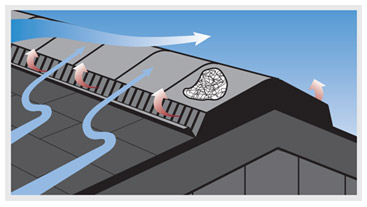Choosing the right roof ventilation system is not just about improving air circulation—it’s about protecting the health of your home and enhancing the comfort of those who live within. Proper roof ventilation can significantly affect your home’s longevity and energy efficiency, and neglecting this crucial aspect can lead to a myriad of issues, from mold growth to wasted energy. In this comprehensive guide, we’ll explore why roof ventilation is vital and how you can select the best system to breathe new life into your home.

Why is Roof Ventilation Important?
Roof ventilation plays a pivotal role in the well-being of your home. It involves the flow of air through your attic, which helps maintain an ideal temperature and moisture level in the roof’s structure. This can be especially important for humid areas like the Southeast. Ventilation can help prevent mold and mildew and for roof replacements in New Orleans, LA it is essential. Here are some reasons why proper ventilation is crucial:
- Temperature Regulation: During summer, a ventilated roof helps expel hot air, reducing the burden on your air conditioning system. In winter, it minimizes the accumulation of warm air in the attic, which can lead to ice damming on the roof’s surface.
- Moisture Control: Adequate ventilation reduces the potential for dampness trapped in the attic, which can lead to rot, mold, and mildew. These issues can compromise the structural integrity of your home and the quality of indoor air.
- Energy Efficiency: An effectively ventilated roof helps balance the attic’s temperature, reducing the energy consumption required for heating and cooling your home, which can lead to significant cost savings.
- Extended Roof Life: By controlling temperature and moisture, a good ventilation system can prevent the premature aging and warping of roofing materials.
Types of Roof Ventilation Systems
Understanding the different types of roof ventilation systems is the first step in choosing the right one for your home. Here are some common types:
- Ridge Vents: These are installed along the ridge line of the roof and are among the most effective ventilation systems. They allow hot air to escape from the attic naturally without being visible from the ground.
- Soffit Vents: These are located under the eaves of the roof where the roof overhangs the walls. Soffit vents draw cool air into the attic at the lowest point of the roof, working in conjunction with ridge vents to promote natural air circulation.
- Gable Vents: Installed near the peak of the gable ends of the house, these allow moisture and heat to escape. They are more effective in regions with cooler climates and can be used in tandem with other venting systems.
- Powered Vents: Including both solar-powered and electric options, these vents use a motor to expel hot air from the attic. They are particularly effective for large roofs or those with complicated designs.

Factors to Consider When Choosing Roof Ventilation
Selecting the best roof ventilation system involves more than just picking a type. Consider these factors to ensure optimal performance:
- Roof Design: The design of your roof affects the type of ventilation that will work best. Complex roof structures might require a combination of vent types to achieve balanced air flow.
- Local Climate: Your local climate plays a crucial role in determining the appropriate ventilation system. For example, homes in hot, humid climates may benefit from more aggressive ventilation solutions.
- Existing Ventilation: Evaluate your current ventilation system’s effectiveness. An inspection can help identify if additional vents are needed or if a different type of system would be more effective.
- Energy Efficiency Goals: Consider how your choice of roof ventilation will impact your energy efficiency. For instance, solar-powered vents can provide excellent ventilation without increasing your energy bill.
- Aesthetic Preferences: Some ventilation options, like ridge vents, are less visible and maintain the aesthetic appeal of your house. Decide what visual impact you are comfortable with when selecting a ventilation system.
Professional Installation vs. DIY
While DIY projects can be tempting, professional installation of roof ventilation is recommended. Incorrect installation can lead to reduced effectiveness of the system and potentially severe damage to your roof. Professionals will ensure that the ventilation is installed according to building codes and manufacturer’s guidelines, providing peace of mind and maximizing the performance of your roofing system.
Maintaining Your Roof Ventilation System
Once installed, regular maintenance of your roof ventilation system is essential to ensure it continues to function effectively. This includes cleaning vents to remove any blockages, checking for signs of damage, and making sure they are not covered by insulation or other materials.
Conclusion
Choosing the right roof ventilation system is vital for maintaining the structural integrity and comfort of your home. By understanding the different types of systems available and considering the specific needs of your home and local climate, you can select a system that optimizes airflow and temperature regulation. Remember, professional installation and regular maintenance are key to the long-term success of your roof ventilation system. To consult with the best roofing company in Birmingham click here!
By investing in the right roof ventilation, you are not just installing a functional system
